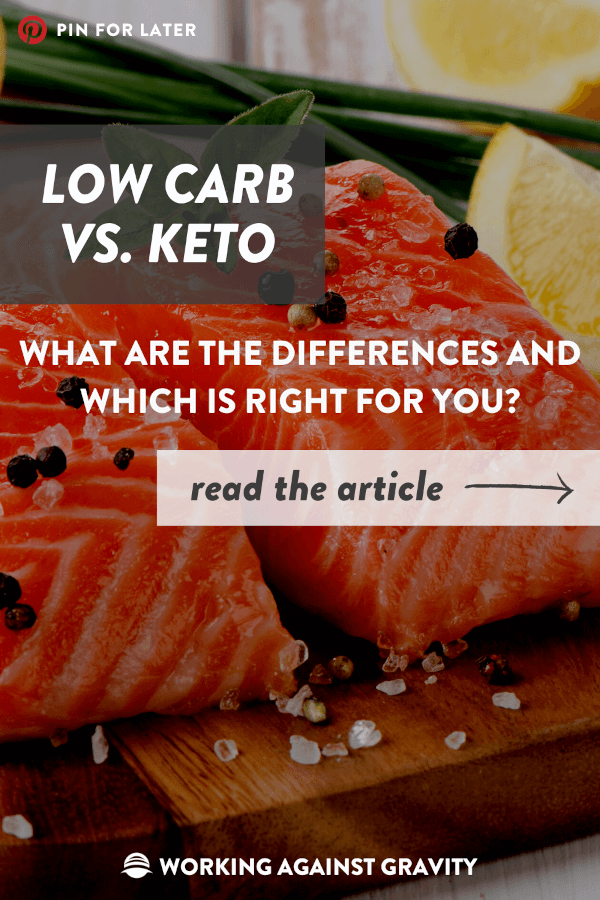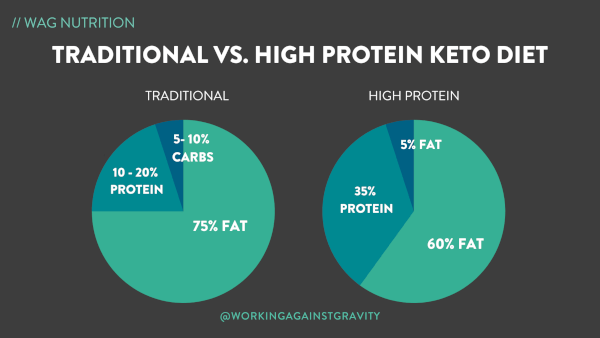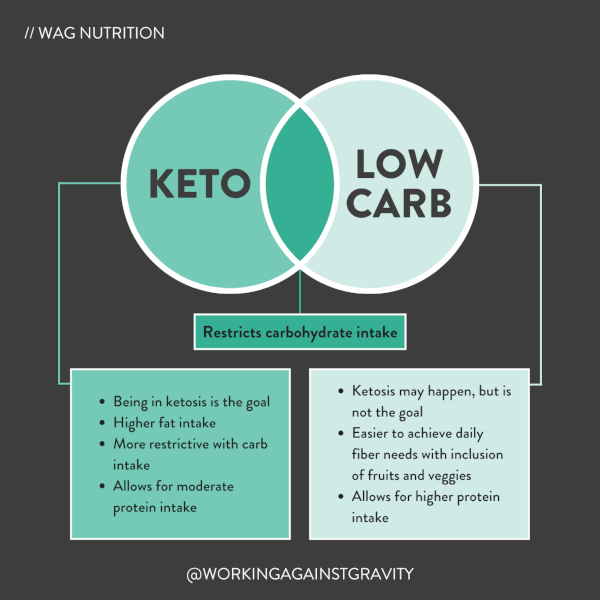At first glance, low-carb diets and keto diets may seem similar in that they both limit carb intake. However, these diet types differ in a few key ways. Knowing the differences between a low-carb diet and a keto diet will help you choose the proper diet based on your goals, lifestyle, and preferences.
To get you started, here is a brief rundown of low-carb vs. keto, who may benefit from each, and how to decide which is best for you.

What is a Low Carb Diet?
Let’s start with a common question, “what is a low-carb diet?”
The USDA 2020-2025 dietary guidelines for Americans recommend that carbohydrates make up 45% to 65% of your total daily calories [1]. So, if you eat 1800 calories per day, 810-1170 calories come from carbs which translates to about 202-292 grams. Eating a “low-carb diet” simply means eating fewer carbs than recommended.
Advertisement
But, how many carbs are in a low-carb diet? Although exact amounts are different for everyone, a typical low-carb diet is around 50 to 100 grams of carbs per day.
Who Benefits from a Low-Carb Diet?
A low-carb diet is beneficial for people who want to lose weight or who are at risk for type 2 diabetes or heart disease [2]. A low-carb diet lowers triglycerides (which carry fat in the bloodstream) and can increase HDL (the good kind of cholesterol) [3].
Who Doesn’t Benefit from a Low-Carb Diet?
Although there are exceptions to every rule, a low-carb diet is typically harmful to high-level athletes who follow intense training schedules since they require more fuel to maintain performance and recovery.
A very low-carb diet is also not recommended for pregnant individuals unless otherwise directed by an OBGYN.
Advertisement
Best Foods for a Low-Carb Diet
When following a low-carb diet, carbohydrates come from slower-digesting carbs—or those that don't raise your blood sugar too high, too quickly. Some examples of these types of carbs are:
- Non-starchy veggies, such as bell peppers, tomatoes, cauliflower, broccoli, or leafy greens like kale
- Nuts and seeds, including nut butter
- Low-sugar fruits, like apples, berries, melon, and avocado
You can also consume carbs from smaller portions of beans, legumes, or starchy vegetables like sweet potatoes and carrots.
Pros and Cons of a Low-Carb Diet
When deciding if a low-carb diet is best for you, it is essential to understand the benefits and challenges that come with the shift. Let’s dig into them:
Pros of a Low-Carb Diet
- Can lead to weight loss
- Excludes high-carb foods that don’t have a lot of nutrient density, like pizza, cake, cookies, processed cereals, and bread
- Can balance blood sugar levels and make you more responsive to insulin, which reduces your risk of health problems, like high blood pressure, heart disease and type 2 diabetes
- May help reduce sugar cravings
Cons of a Low-Carb Diet
- Can be challenging to maintain, especially for carb lovers
- Can be harder to meet nutrient needs, since you must eliminate some food groups
- Can decrease performance and recovery from high-intensity exercise
Now that we’ve covered the ins and outs of a low-carb diet, let’s move onto keto.
Advertisement
What is a Keto Diet?
A Keto diet is characterized by low consumption of carbs, a moderate amount of protein, and a high intake of fat. Typically, your body uses glucose (from carbs) as its energy source and whatever the body does not use is stored as glycogen in your muscles and liver.
When following a Keto diet—and eating significantly fewer carbohydrates—your body does not have glycogen stored to use as fuel, so instead relies on fat stores, hence the high fat component of keto.
As your body breaks down stored fat for energy, it produces ketones. Three ketones are acetone, beta-hydroxybutyrate, and acetoacetate (which converts to BHB). If you have followed a keto diet for a while, your body automatically breaks down fat for energy rather than carbs. When this happens, your body is in ketosis, a normal metabolic process.
Who Benefits from a Keto Diet?
Is keto right for you? The keto diet benefits those who struggle with weight loss, have joint pain caused by inflammation, or prefer higher-fat foods. It can also benefit people with a history of seizures, neurodegenerative disorders, or head injuries and those who are insulin-resistant or gluten intolerant. Check out these real results, including benefits, from WAG Founder Adee’s 90-day keto experiment.
Who Doesn’t Benefit from a Keto Diet?
Like the low-carb diet, keto is unsuitable for pregnant people. People who are type I diabetic should also avoid a ketogenic diet. Our coaches have also found that those with muscle gain or performance goals typically do better with more carbohydrates in their diet.
Advertisement
Keto may also be tricky—though not impossible—for vegetarians and vegans. If you are considering a keto diet and have an underlying health condition, check with your healthcare provider before making significant changes.
Best Foods for a Keto Diet
When following the Keto diet, most of your calorie intake will come from healthy fats, like these:
- Avocados and avocado oil
- Olives and olive oil
- Nuts and seeds, like macadamia nuts, chia seeds and hemp seeds
- Butter (ideally, grass-fed)
- Some high-quality cheese
Although the Keto diet emphasizes high fat intake, it is still important to eat quality carbohydrates and protein. When designing a keto meal, your carbs will come from non-starchy and higher volume veggies, like broccoli, cauliflower, asparagus, and leafy greens such as kale or spinach or lower carb fruit like strawberries and raspberries. Your protein may come from steak, chicken thighs, salmon, whole milk, Greek yogurt, or cheese.
Keto Diet Macros
So, how many carbs can you eat during a keto diet? And how much fat and protein do you need during a keto diet? Like the low-carb diet, the exact macronutrient breakdown will depend on the individual, but the graph below shows a general starting place.
It is essential to find what works for you and your goals. For example, someone who does resistance weight training five days a week might follow keto using a macronutrient breakdown with a higher protein intake.
Advertisement

Pros of a Keto Diet
- Mental clarity
- Satiation
- Change in body composition
- Quick weight loss due to increased fat burn and drop in water weight
- Easy to follow (foods are either keto food or not, plus a lot of restaurants advertise and label menu items as “keto-friendly”)
- Gives your body the ability to switch between burning fat and burning glucose
- Can potentially improve a variety of health conditions including heart disease, diabetes, epilepsy, and MS [4].
Cons of a Keto Diet
- Requires testing to monitor whether you are in ketosis (this can be time-consuming or expensive depending on the method and testing frequency you choose)
- May experience side effects such as the keto flu, GI distress, low blood sugar, or low energy at the onset of diet (and can happen every time you exit ketosis and enter again)
- Depending on what your current diet looks like, it can require some lifestyle changes
- Harder to meet your fiber needs without a supplement
- Can reduce performance and power during high-intensity exercise
- Can be harder to sustain than a low-carb diet
The Difference Between Low Carb and Keto
While low carb and keto are similar in that they require less carbohydrate intake than a standard diet, they differ in a few distinct ways.

No matter which diet you choose, limiting carbs is can be HARD! But with the help of a WAG nutrition coach, it is a lot easier.
Transitioning from a Keto Diet to a Low-Carb Diet
Here are some general guidelines for transitioning from a keto diet to a low-carb diet.
Advertisement
Things to consider as you transition from Keto to Low Carb
- Carb quality: It is tempting to fill your daily carb intake with sugary treats once you have more room to play, but it is important to focus on whole food, and high-fiber carb sources that limit sugar cravings and keep you feeling full.
- Slowly adding carbs each week: Generally speaking, you should increase your carb intake by 10-15% while decreasing your fats by 10-15% over the first two weeks of your transition. After that, you can increase your carb intake by 20% and decrease your fat intake by 20%.
- Knowing that a bit of water weight may happen: This will take care of itself, but you may experience increased feelings of hunger and notice scale fluctuations in the meantime. Drinking plenty of water and getting enough sleep can help mitigate this.
Paleo, Keto, low-carb, or any diet has the potential to be a healthy and effective option depending on your goals. Nutrition is not one size fits all. Working with a WAG nutrition coach can help determine what is right for you!
References:
- U.S. Department of Health and Human Services and U.S. Department of Agriculture. 2020 – 2025 Dietary Guidelines for Americans. 9th Edition. Available at https://www.dietaryguidelines.gov/sites/default/files/2020-12/Dietary_Guidelines_for_Americans_2020-2025.pdf
- Mayo Clinic. Weight Loss. Low-carb diet: Can it help you lose weight? Available at https://mayoclinic.org/healthy-lifestyle/weight-loss/in-depth/low-carb-diet/art-20045831#:~:text=Low-carb%20diets%20that%20emphasize,cholesterol%20levels%2C%20at%20least%20temporarily
- Harvard T. H. Chan School of Public Health. The Nutrition Source. Available at https://www.hsph.harvard.edu/nutritionsource/carbohydrates/low-carbohydrate-diets/
- Brenton, J. N., Banwell, B., Bergqvist, C., Lehner-Gulotta, D., Gampper, L., Leytham, E., Coleman, R., Goldman, M.D. (2019). Pilot study of a ketogenic diet in relapsing-remitting MS. Neurology Neuroimmunology Neuroinflammation, 6 (4) e565; DOI: 10.1212/NXI.0000000000000565








